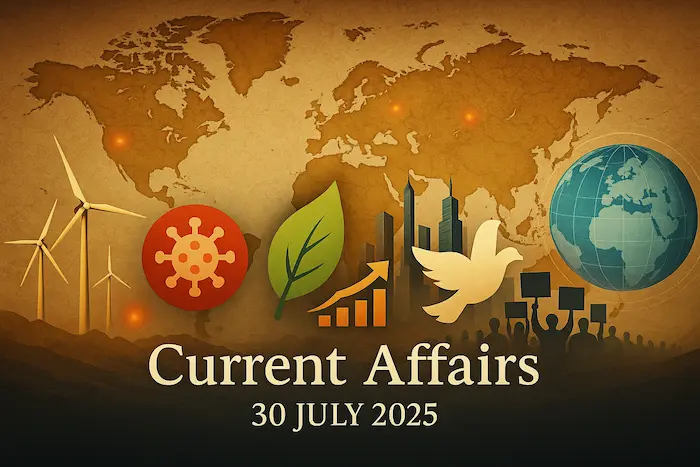1. India Notifies Environment Protection Rules, 2025 to Address Chemically Contaminated Sites – Environment

Why in News?
The Ministry of Environment, Forest and Climate Change (MoEF&CC) has officially notified the Environment Protection (Management of Contaminated Sites) Rules, 2025.
This marks a major policy shift in how India identifies, assesses, and remediates chemically contaminated sites.
What are Contaminated Sites?
Contaminated sites are locations polluted by hazardous chemicals and industrial waste, usually due to poor waste management in the past. These include:
- Defunct industrial landfills
- Abandoned chemical factories
- Illegal hazardous waste dumping grounds
- Waste storage or spill locations
Such sites pose serious risks to public health, groundwater, and ecosystem integrity.
Need for the New Rules
- Historical pollution in India remains unaddressed due to lack of a uniform legal framework.
- Past efforts to clean up were fragmented, lacked accountability, and were not time-bound.
- Only 7 of 103 identified contaminated sites are under remediation currently.
Key Features of the Rules (2025)
- Legally Binding Framework
- Ensures compulsory compliance by polluters and government agencies.
- Systematic Remediation Process
Steps include:- Site identification
- Preliminary assessment
- Detailed site investigation
- Remediation planning
- Cost recovery from responsible parties
- Time-Bound Action Plans
- Deadlines and roles for government and polluters are clearly defined.
- Exemptions to Avoid Overlap
These rules do not apply to:- Radioactive waste
- Mining-related contamination
- Marine oil pollution
- Municipal solid waste dump sites
Significance of the Rules
- Public Health: Prevents long-term exposure to carcinogens and toxins.
- Environmental Safety: Protects soil, water, and biodiversity.
- Regulatory Clarity: Replaces piecemeal enforcement with a uniform legal mechanism.
- Polluter Pays Principle: Ensures cost recovery from responsible parties.
Challenges in Implementation
- Scientific & Technical Capacity
- India needs experts and labs to identify and assess chemical risks.
- Coordination Among Agencies
- Pollution control boards, local governments, and industries must work together.
- Financial Resources
- Remediation is expensive; need for both public and private investment.
- Public Awareness & Local Involvement
- Community participation is essential for effective implementation and monitoring.
Relevance to Himachal Pradesh
- Industrial pockets in Baddi-Barotiwala-Nalagarh (BBN) region may face similar contamination risks.
- The rules may help in identifying legacy pollution issues in HP’s industrial zones.
Exam Connect – Possible Questions
Prelims
1. The Environment Protection (Management of Contaminated Sites) Rules, 2025 apply to which of the following?
1.Sites contaminated due to radioactive waste
2.Sites with legacy hazardous industrial waste
3. Municipal solid waste landfill sites
4.Marine oil pollution zones
Select the correct option:
A. 1 and 2 only
B. 2 only
C. 1, 2 and 3 only
D. 2 and 4 only
Answer: B. 2 only
2. Which of the following is not a feature of the Environment Protection (Management of Contaminated Sites) Rules, 2025?
A. Legally binding timelines for remediation
B. Inclusion of radioactive waste sites
C. Polluter pays principle
D. Structured site assessment and remediation process
Answer: B. Inclusion of radioactive waste sites
Mains
1. “The Environment Protection (Management of Contaminated Sites) Rules, 2025 represent a paradigm shift in India’s environmental governance.” Discuss the significance of these rules and the challenges associated with their implementation.
2. “Legacy pollution is as critical as present-day emissions.” Evaluate the need for addressing historically contaminated sites in India’s environmental policy framework.
2. The Yarlung Tsangpo Hydropower Project: Strategic, Ecological, and Geopolitical Implications for India – International Relations
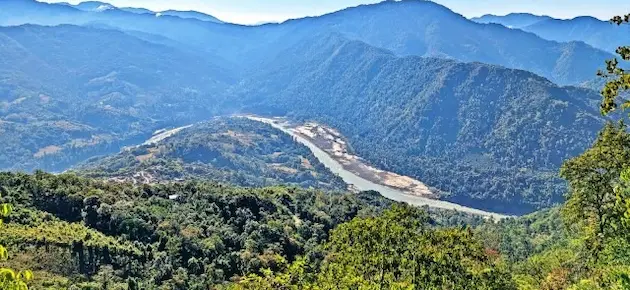
Why in News?
China has recently begun constructing a massive hydropower project on the Yarlung Tsangpo River in Tibet, close to the Indian border near Arunachal Pradesh.
The lack of prior consultation with downstream nations like India and Bangladesh, as well as the project’s scale, location, and secrecy, have triggered serious strategic and environmental concerns.
About the Yarlung Tsangpo River
- Originates in Tibet and enters India in Arunachal Pradesh as the Siang River, before becoming the Brahmaputra in Assam.
- It is one of the highest rivers in the world and a lifeline for northeastern India and Bangladesh.
Project Overview
- Estimated Cost: 1.2 trillion yuan (~US$167.8 billion)
- Scale: 5 hydropower plants in Medog County, about 30 km from Arunachal Pradesh
- Power Generation: Target of 300 billion kWh annually – more than the Three Gorges Dam
- Engineering Plan:
- Tunneling and diverting up to 50% of the river’s flow
- Construction in a high seismic risk zone
Strategic & Geopolitical Concerns for India
- Water Weaponization
- China controls the river’s upper course. Large-scale diversion can be used to manipulate water availability to downstream countries.
- Lack of Transparency
- China’s opaque planning and refusal to share hydrological data raises questions about its intentions and accountability.
- Security Risks
- Located near the Line of Actual Control (LAC); could have dual-use strategic infrastructure implications, potentially supporting military logistics.
- Geopolitical Asymmetry
- India has little leverage due to China’s upstream position and its non-adherence to international watercourse treaties.
Ecological & Hydrological Risks
- River Flow Disruption: Seasonal flow alterations will impact agriculture, biodiversity, and river-based livelihoods in Assam and Bangladesh.
- Flooding Risk: Sudden water release or dam failure in seismic conditions could cause catastrophic downstream flooding.
- Biodiversity Threats: Riverine ecosystems, particularly in Arunachal Pradesh and Assam, face long-term degradation.
Legal and Diplomatic Dimensions
- No Binding Treaty: Neither India nor China is a signatory to the UN Convention on the Law of Non-Navigational Uses of International Watercourses (1997).
- China’s Record: History of unilateral river management with little regard for riparian cooperation.
- Diplomatic Challenges: India’s protests have been symbolic; no institutional mechanism currently exists to resolve such disputes bilaterally or multilaterally.
Policy Recommendations for India
- Diplomatic Engagement
- Demand transparency and real-time data sharing on river flows.
- Engage in track-2 diplomacy and regional dialogue with Bangladesh and Nepal.
- Strengthen Domestic Resilience
- Invest in flood forecasting, water storage, and river interlinking projects.
- Conduct independent environmental impact assessments in border states.
- Internationalize the Issue
- Leverage international environmental forums, civil society networks, and regional coalitions (like BIMSTEC) to highlight the issue.
- Collaborate with global NGOs and academic institutions to monitor changes via satellite and ground data.
Relevance for Himachal Pradesh
While not directly impacted, HP’s hydro-geopolitical future may also be influenced by transboundary water governance frameworks. Lessons from Brahmaputra basin management can be applied to Indus and Sutlej rivers, where China also has upstream control.
Exam Connect – Possible Questions
Prelims
1. The Yarlung Tsangpo River enters India as which of the following rivers?
A. Teesta
B. Subansiri
C. Siang
D. Lohi
Answer: C. Siang
2. Which of the following statements about the Yarlung Tsangpo Hydropower Project is/are correct?
1. It is located near the border of Arunachal Pradesh.
2. China has signed the UN Convention on International Watercourses.
3. The project’s electricity generation capacity exceeds that of the Three Gorges Dam.
Select the correct answer:
A. 1 and 2 only
B. 1 and 3 only
C. 2 and 3 only
D. 1, 2 and 3
Answer: B. 1 and 3 only
Mains
1. “China’s upstream control of transboundary rivers poses both environmental and strategic challenges for India.”
Examine the implications of the Yarlung Tsangpo Hydropower Project on India’s ecological security and diplomatic posture.
2. Discuss the gaps in international water governance and evaluate India’s preparedness to manage upstream hydro-infrastructure projects by neighboring countries.
3. Lessons from the Chola Legacy: Governance, Architecture, and Modern Relevance – History & Culture
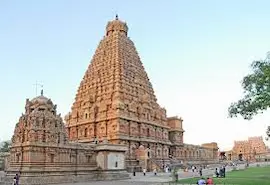
Why in News?
Prime Minister Narendra Modi’s visit to Tamil Nadu during the Aadi Thiruvathirai festival has renewed interest in the Chola dynasty, particularly its legacy in governance, infrastructure, and cultural identity.
The emphasis on Rajendra Chola I’s administration reflects not only cultural pride but also a political messaging on the value of decentralized governance and heritage preservation.
Who Were the Cholas?
- One of the longest-ruling dynasties in southern India (c. 9th to 13th centuries CE).
- Reached imperial glory under Rajaraja Chola I and Rajendra Chola I.
- Known for:
- Effective administration
- Advanced engineering and water management
- Temple architecture
- Maritime trade and naval power
Key Contributions and Their Modern-Day Relevance
1. Village Self-Governance (Sabhas)
- Chola local assemblies had autonomy over taxation, public works, and judicial matters.
- Uttaramerur Inscriptions provide a detailed account of electoral procedures, including eligibility, disqualification, and selection by lottery.
Modern Relevance:
Reflects grassroots democracy. Strong precedent for Panchayati Raj Institutions (PRIs) post-73rd Amendment. Offers a model for transparent and accountable local elections.
2. Land and Revenue Administration
- Conducted detailed land surveys and categorized land based on fertility and productivity.
- Enabled fair and efficient tax collection.
Modern Relevance:
Informs GIS-based land mapping, digitized revenue records, and smart property taxation systems in urban and rural local bodies.
3. Sustainable Infrastructure Development
- Temples like Brihadisvara (Thanjavur) were built to last, showcasing precision engineering.
- Use of interlocking stones, weight distribution, and granite foundations ensured structural longevity.
Modern Relevance:
Inspires earthquake-resilient construction, especially important for seismic zones like Himachal Pradesh.
4. Water Management and Irrigation
- Extensive tank systems, check dams, and canals were constructed.
- Emphasized community involvement in maintenance and resource sharing.
Modern Relevance:
Applicable to climate-resilient agriculture, rainwater harvesting, and decentralized water governance in drought-prone regions.
5. Cultural and Maritime Achievements
- Promoted art, literature, sculpture, and Bhakti movement.
- Built vast naval fleets, establishing trade routes to Southeast Asia.
- Spread Indian culture and religion abroad.
Modern Relevance:
Boosts cultural nationalism, promotes soft power diplomacy, and highlights India’s historical maritime legacy (relevant to SAGAR and Act East Policy).
Connecting the Chola Model to the Constitution
- 73rd and 74th Constitutional Amendments (1992) focus on decentralisation and urban self-governance.
- Chola-era village assemblies reflect the same spirit of local empowerment and civic participation.
Significance for Himachal Pradesh
- While not part of Chola geography, HP can draw from:
- Water harvesting and community irrigation systems for hill agriculture.
- Seismic-resilient temple architecture applicable to heritage sites in Kangra and Kinnaur.
- Lessons in local body empowerment through PRIs.
Exam Connect – Possible Questions
Prelims
1. Which of the following inscriptions is associated with village self-governance in the Chola Empire?
A. Allahabad Pillar Inscription
B. Aihole Inscription
C. Uttaramerur Inscription
D. Nasik Inscription
Answer: C. Uttaramerur Inscription
2. With reference to the Brihadisvara Temple, consider the following:
1. It is built using interlocking granite stones.
2. It was constructed during the rule of Rajendra Chola I.
3. It demonstrates principles of seismic resilience.
Which of the statements given above is/are correct?
A. 1 and 2 only
B. 1 and 3 only
C. 2 and 3 only
D. 1, 2 and 3
Answer: B. 1 and 3 only
Mains
1. “The Chola model of governance reflects the values enshrined in India’s modern decentralised administrative system.”
Discuss with reference to the 73rd and 74th Constitutional Amendments.
2. What lessons can modern India learn from the Chola dynasty in the areas of sustainable development, local governance, and disaster-resilient infrastructure? Illustrate with examples.
4.Justice on Hold: India’s Courts are Clogged with Pending Cases – Polity
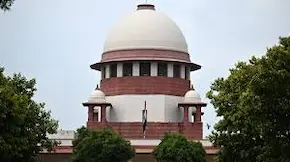
Why in News?
India’s legal system is facing a severe judicial backlog, with over 4.5 crore cases pending across various levels of courts.
This rising pendency raises concerns about the efficiency, accessibility, and credibility of the justice delivery system.
Judicial Backlog: The Current Crisis
- Over 4.5 crore cases are pending as of 2024.
- Delayed justice erodes public confidence in the judiciary.
- Pendency undermines the “justice delayed is justice denied” principle, guaranteed under Article 21 (Right to Life and Personal Liberty).
Key Reasons for Judicial Delays
1. Judicial Vacancies
- Over 30% of High Court judges’ positions remain vacant.
- Leads to increased caseloads per judge, making timely disposal nearly impossible.
2. Inadequate Infrastructure
- Many courts lack basic amenities, courtroom space, and IT infrastructure.
- Poor working conditions delay hearings and case management.
3. Procedural Inefficiencies
- Frequent adjournments, outdated procedures, and delay tactics by litigants extend the life of cases.
- For example, civil suits can stretch for decades due to procedural loopholes.
4. Ineffective Case Management Systems
- Lack of automated case tracking, poor digitization, and absence of real-time data sharing hinder swift decision-making.
Alternative Dispute Resolution (ADR): A Way Forward
1. Mediation and Arbitration
- Resolve cases outside formal court structures, reducing litigation burden.
- Example: The Delhi Mediation Centre has resolved over 2 lakh cases since 2005.
2. Lok Adalats
- Fast-track, informal courts for compoundable and civil disputes.
- A recent National Lok Adalat settled 1 crore cases in one day, showcasing the potential of ADR.
3. Fast Track Courts & Gram Nyayalayas
- Intended to speed up trials in specific categories, like sexual offences and juvenile justice.
- Often underutilized due to lack of staff, funding, and awareness.
Policy Solutions and Reforms Needed
- Increase Judicial Appointments
- Expedite the Collegium and appointment process, particularly for lower judiciary.
- Judicial Infrastructure Development
- Invest in e-courts, video conferencing, and smart case management tools.
- Procedural Reforms
- Curb adjournments, simplify procedural codes, and implement pre-trial case filtration.
- Strengthen ADR Ecosystem
- Institutionalize mediation at all court levels and improve training for arbitrators.
- Legal Literacy & Outreach
- Educate citizens on ADR benefits and legal rights, especially in rural areas.
- Data Transparency and Judicial Performance Metrics
- Publish court-wise pendency data, judge productivity reports, and case disposal trends.
Relevance to Himachal Pradesh
- HP’s lower courts also face pendency due to lack of judges and inadequate digital infrastructure.
- Emphasis on mobile courts, ADR, and village legal aid programs can help decentralize justice delivery in hilly and remote areas.
Exam Connect – Possible Questions
Prelims
1. Which of the following correctly describes the function of Lok Adalats in India?
A. Resolve only criminal cases through a formal court trial
B. Adjudicate tax disputes under the Income Tax Act
C. Resolve civil and compoundable criminal cases through compromise
D. Hear appeals from High Courts
Answer: C. Resolve civil and compoundable criminal cases through compromise
2. With reference to judicial reforms in India, consider the following statements:
1. The 42nd Constitutional Amendment introduced the concept of Lok Adalats.
2. Mediation and arbitration are examples of Alternative Dispute Resolution (ADR) mechanisms.
3. The number of High Court judges in India is fixed and cannot be changed.
Which of the above statements is/are correct?
A. 1 and 2 only
B. 2 only
C. 2 and 3 only
D. 1, 2 and 3
Answer: B. 2 only
Mains
1. “India’s judicial pendency is not just an administrative issue but a constitutional challenge.” Examine the causes and suggest structural reforms needed to improve judicial efficiency.
2. Discuss the role of Alternative Dispute Resolution (ADR) mechanisms in reducing judicial burden in India. How can these methods be institutionalized to enhance access to justice?
5. State of Food and Nutrition in the World (SOFI) 2025 Report: Alarming Trends for India – Indian Society
Why in News?
The 2025 State of Food Security and Nutrition in the World (SOFI) report, published by UN agencies such as the FAO, UNICEF, and WHO, reveals critical findings regarding malnutrition and anaemia in India, signaling a major public health challenge.
About the SOFI Report
- An annual flagship report by FAO, IFAD, UNICEF, WFP, and WHO.
- Tracks progress toward SDG 2 – Zero Hunger.
- Focuses on:
- Hunger and food insecurity
- Malnutrition (undernutrition and obesity)
- Access to affordable healthy diets
Global Findings
- Global hunger rate has marginally improved:
From 8.5% in 2023 to 8.2% in 2024, but still affects 735 million people. - Double burden of malnutrition:
- Rise in undernutrition due to poverty and conflict.
- Surge in obesity due to poor diet quality, sedentary lifestyles, and food marketing.
- Cost of a healthy diet globally has increased, limiting access for vulnerable groups.
India-Specific Findings: A Dual Crisis
Child Malnutrition
- Wasting (Low weight-for-height)
- 18.7% of children under 5 are wasted.
- India has the highest number globally (21 million).
- Stunting (Low height-for-age)
- Affects 37.4 million children, reflecting chronic undernutrition.
- Overweight Children
- 4.2 million, up from 2.7 million in 2012 – indicating rising childhood obesity.
Women’s Health
- Anaemia among Women (15–49 years):
- 53.7% affected, or over 203 million women.
- A key indicator of poor dietary intake and maternal health.
Undernourishment and Diet Affordability
- 12% of India’s population (172 million) is undernourished.
- 42.9% of people can’t afford a healthy diet.
- Cost increased from $2.77 in 2017 to $4.07 in 2024.
Adult Obesity
- 71.4 million adults now obese – the number has doubled in a decade.
- Reflects increasing urban lifestyle diseases and dietary imbalances.
Key Challenges for India
- Persistent child undernutrition despite welfare schemes like ICDS and POSHAN Abhiyaan.
- Rise in non-communicable diseases (NCDs) due to obesity.
- Economic inequalities making healthy food unaffordable.
- Poor dietary diversity and low awareness among populations.
- High gender disparity in nutritional indicators (e.g., anaemia in women).
Implications for Policy and Society
Public Health
- Stunting and wasting impact cognitive development, future workforce productivity, and maternal outcomes.
Social Justice
- Malnutrition disproportionately affects marginalized communities, reflecting structural inequalities in food distribution, access, and awareness.
Economic Impact
- Malnutrition costs India billions in lost productivity and increased healthcare burden.
Global Standing
- Fails progress on SDG 2 (Zero Hunger) and SDG 3 (Good Health & Well-being).
Way Forward
- Strengthen Poshan Abhiyaan & ICDS
- Focus on last-mile delivery, maternal care, and convergence of schemes.
- Promote Dietary Diversity
- Encourage millets, pulses, and regional food crops through awareness and subsidies.
- Targeted Anaemia Control Programs
- Expand IFA supplementation, deworming, and nutrition education.
- Address Obesity and NCDs
- Tax ultra-processed foods, promote physical activity, and regulate food marketing.
- Subsidized Healthy Diet Access
- Extend Public Distribution System (PDS) to include nutritious food baskets.
- Improve Monitoring
- Use real-time nutrition dashboards and local-level data collection.
Relevance to Himachal Pradesh
- Hill states like HP are seeing increasing cases of hidden hunger and rising obesity in urban pockets.
- Tribal and rural women show high levels of anaemia due to low access to health services.
- Local solutions using kitchen gardens, mid-day meals, and community nutrition campaigns are key.
Exam Connect – Possible Questions
Prelims
1. The “State of Food Security and Nutrition in the World (SOFI)” Report is published by which of the following organisations?
A. World Economic Forum
B. Food and Agriculture Organization (FAO)
C. United Nations Development Programme (UNDP)
D. International Food Policy Research Institute (IFPRI)
Answer: B. Food and Agriculture Organization (FAO)
2. Which of the following is/are indicators of child undernutrition used in SOFI Reports?
1. Stunting
2. Wasting
3. Obesity
4. Anaemia
Select the correct answer:
A. 1 and 2 only
B. 1, 2 and 3 only
C. 2 and 4 only
D. 1, 2, 3 and 4
Answer: B. 1, 2 and 3 only
Mains
1. “India is facing the dual burden of undernutrition and obesity.” Discuss the challenges posed by this nutritional paradox and suggest multi-sectoral solutions.
2. Examine the gender-specific challenges revealed by the SOFI 2025 Report in India. How can public health policies be more inclusive toward women’s nutritional needs?
6. Gavri Festival: Preserving the Tribal Cultural Heritage of Mewar – History & Culture
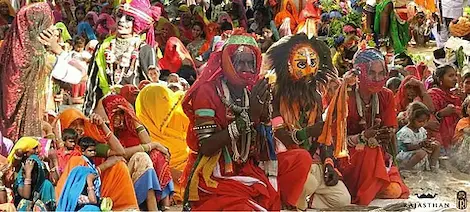
Why in News?
The Gavri Festival, a traditional tribal celebration of the Bhil community in Mewar, Rajasthan, is once again being observed, showcasing centuries-old cultural practices through ritualistic dance-drama.
About the Gavri Festival
- A 40-day annual festival, generally held after the monsoon.
- Celebrated predominantly in the Udaipur, Rajsamand, and Chittorgarh districts of Rajasthan.
- Marks devotion to Goddess Amba (a form of Durga), symbolizing the victory of good over evil.
Cultural Significance
- Rooted in ancient oral traditions of the Bhil tribe, with estimated origins in the 3rd–4th century CE.
- Historically referenced during the reign of Siddh Raj Jai Singh (Solanki dynasty, Gujarat), indicating its wide cultural influence.
Key Elements of the Festival
1. Ritual Dance-Drama (Gavri / Rai Nach)
- Combines dance, drama, and mime, often performed in village centers or open spaces.
- Central story: Goddess Amba defeats the demon Bhiamwal, symbolizing moral and cosmic order.
2. All-Male Cast
- Only men participate, even in female roles, maintaining traditional performance practices.
- Reflects similar patterns in other folk theatres like Yakshagana and Therukoothu.
3. The Role of the Kutkadiya
- A narrator and guide who introduces each scene and provides context to the audience.
- Enhances comprehension, encourages reflection, and adds humour and satire.
4. Costumes & Music
- Performers wear vivid costumes, headgear, and body paint.
- Accompanied by traditional instruments like dhol, thali, and shehnai, creating a lively rural theatrical atmosphere.
Social and Spiritual Impact
- Considered spiritually purifying for performers.
- Ensures prosperity and protection for families involved.
- Fosters community bonding, inter-generational knowledge transfer, and tribal identity preservation.
Contemporary Relevance
- Amid concerns of cultural dilution, Gavri remains a stronghold of tribal resilience and indigenous knowledge systems.
- Increasingly being recognized in folk theatre studies and UNESCO’s intangible cultural heritage frameworks.
Comparison with Other Tribal/Folk Festivals
| Festival | Region | Community | Theme |
|---|---|---|---|
| Gavri | Rajasthan (Mewar) | Bhils | Good vs Evil (Amba vs Bhiamwal) |
| Karam Festival | Jharkhand/MP | Oraon/Santhal | Nature worship, community prosperity |
| Bhagoria | MP (Jhabua) | Bhil/Bhilala | Matchmaking, spring harvest |
| Chhau Dance | Odisha/Jharkhand | Local tribes | Mythological dance-drama |
Relevance to Himachal Pradesh
- While HP does not celebrate Gavri, it has similar folk festivals like Kullu Dussehra, and local deota-based performances, showing how folk culture serves as a binding and spiritual force across India’s regions.
- Documentation of oral traditions and promotion of local art forms are key for tribal and regional identity preservation in HP as well.
Exam Connect – Possible Questions
Prelims
1. Gavri Festival, recently in news, is associated with which tribal community in India?
A. Santhal
B. Bhil
C. Gond
D. Bodo
Answer: B. Bhil
2. Which of the following statements about the Gavri Festival is/are correct?
1. It is performed by both men and women.
2.It combines elements of dance, drama, and mime.
3. The central theme is the victory of Goddess Amba over the demon Bhiamwal.
Select the correct answer:
A. 1 and 2 only
B. 2 and 3 only
C. 1 and 3 only
D. 1, 2 and 3
Answer: B. 2 and 3 only
Mains
1. “Folk festivals like Gavri are not just artistic performances but also expressions of social values and spiritual heritage.”
Discuss the significance of tribal festivals in preserving India’s intangible cultural traditions.
2. Examine the role of oral traditions and folk performances in sustaining regional identity and cultural continuity among tribal communities. Illustrate with examples.

